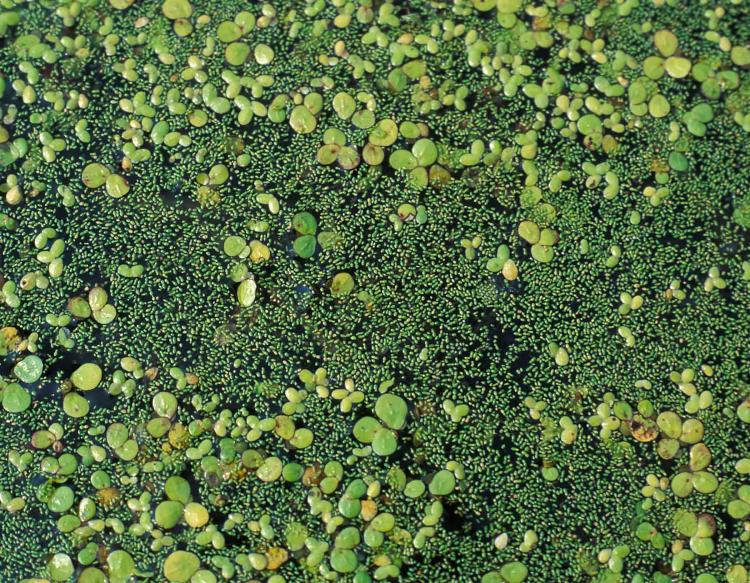Duckweed and watermeal are free floating plants that are commonly found in Missouri waters. Small amounts of duckweed and watermeal will not harm a good pond, but these fast growing aquatic plants that can reach nuisance densities in less than one month. When these plants form a dense growth on the water’s surface, they can block sunlight. This reduces oxygen concentrations and upsets the natural pond balance. Pond owners can control these aquatic plants through mechanical, biological, and chemical methods.
Prevention
Dense growth of duckweed or watermeal is usually linked to high levels of nutrients in the water. Nutrients like nitrogen and phosphorous can come from waterfowl waste, septic tank seepage, and feedlot or fertilizer runoff. Prevent duckweed and watermeal problems by eliminating or diverting these nutrient sources.

Duckweeds are the smallest of the flowering plants. They consist of tiny, green, round, leaflike bodies that float on the water’s surface. There are 4 genera, with 14 species, in the duckweed family recorded for Missouri. This picture shows representatives of at least 3 of the genera: Lemna, Spirodela, and Wolffia.
Photo credit: Jim Rathert
Title
Mechanical Control
Since free-floating plants reproduce so quickly, mechanical methods are only temporary solutions. However, temporary control can make a fishing trip or a swimming party more enjoyable.
For small ponds, collect the free-floating plants by skimming the surface -with small mesh nets, window-screen material, or a seining net.
Simply clearing the pond’s surface will not prevent problems for some older ponds. You may need to drain, dry, and deepen your pond if it becomes shallow due to black muck accumulation. The black muck stores nutrients that fuel the excessive growth of aquatic plants. All excavated material should be removed from the pond’s watershed.
Title
Biological Control
Some people use the plant-eating grass carp to control certain species of aquatic plants. Grass carp may eat some duckweed and watermeal, but these plants reproduce so quickly that the grass carp are generally not an effective control measure.
Title
Chemical Control
Before applying chemicals, read the product label for directions, current restrictions, and warnings. Consider potential contamination of domestic water supplies, waiting periods for watering livestock, eating fish, swimming, and irrigation.
Although herbicides provide good control when applied correctly, improper use can harm desirable organisms. Chemical application leaves large amounts of decaying dead plant material. This can lower dissolved oxygen to lethal levels for fish. For this reason, the Department recommends treating only 1/3 of the plants at 7-10 day intervals until control is obtained.
Since duckweed and watermeal grow very fast, chemical control should begin as soon as the plants appear in the spring. Chemical control can be very expensive and it isn’t permanent; continuous re-treatment will be necessary. Please remember that the long-term effects of most herbicides on the environment are not well known.
For additional information about controlling duckweed and watermeal or calculating required amount of herbicide, download the full Aquaguide below.
Title
Duckweed
Excellent Control
- Carfentrazone (Stingray)
- Flumioxazin (Clipper)
- Penoxsulam (Galleon)
Good-Excellent Control
- Fluridone (Sonar, Avast, WhiteCap, Restore, Fluridone)
Good Control
- Diquat (Reward, Harvester, Tribune, Tsunami DQ, Diquat SPC 2L, Weedtrine D)
Fair Control
- 2,4-D (Navigate, Weedar 64)
Title
Watermeal
Excellent Control
- Flumioxazin (Clipper)
Good Control
- Carfentrazone (Stingray)
- Fluridone (Sonar, Avast, WhiteCap, Restore, Fluridone)
- Penoxsulam (Galleon)
Fair Control
- Bispyribac (Tradewind)
- Diquat (Reward, Harvester, Tribune, Tsunami DQ, Diquat SPC 2L, Weedtrine D)
- 2,4-D (Navigate, Weedar 64)





















